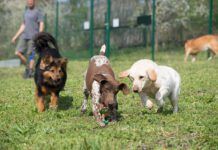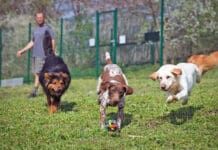[Updated February 1, 2018]
Recently, I adopted a pup from my local shelter. The little guy was about 10 weeks old, had just been neutered, and was ready to get out and about and get socialized! I was looking forward to starting this process, because he was such a calm pup . . . or was he? I started to wonder if Tico’s lack of energy might be due to illness.
Sure enough, within a day or two of coming home with me he started coughing and developed a slightly elevated temperature. Diagnosis: Canine infectious respiratory disease (CIRD), also known as infectious canine tracheobronchitis (ITB), and far more commonly known as “kennel cough.”
For my pup’s “uncomplicated” form of kennel cough, the diagnosis was made based on his history of recent exposure to the disease in the shelter environment and his characteristic clinical sign of a honk-like paroxysmal cough. These coughing “fits” can occur in spasms of 10 to 15 or even 20 coughs in a row.
Typically, clinical signs of infection will appear three to 10 days after exposure; he was right on target at five days. As with the human’s common cold, the disease is often self-limiting. Kennel cough may resolve without treatment in a week or two, or it can worsen and require veterinary attention in order to help the puppy or dog bounce back.

Dogs with the uncomplicated form of kennel cough tend to be otherwise healthy and continue to eat, drink, and play. Their lungs will usually sound normal, but some may experience lethargy and have a slight fever like my young pup. Others may experience nasal discharge and sneezing; still others exhibit only a persistent cough – sometimes dry and hacking, or soft and wet. Excitement, exercise, and changes in temperature or humidity can induce coughing, as can pressure on the trachea, such as from a collar.
A small percentage of infected dogs may have no symptoms at all yet still shed the virus and spread the disease.
But here I had a pup who was still in the critical period of socialization. I knew I had to keep him isolated, but his socialization window was closing fast. Besides, I had already paid for a puppy class that was due to begin in three weeks.
Kennel Cough: Virus or Infection? Both?
CIRD may be associated with an infection from a single virus, bacteria, or it may have a multi-agent etiology. Both the viral and bacterial causes present with similar clinical signs so they are commonly grouped as “kennel cough.”
Very often, a viral pathogen is its primary agent, infecting the epithelium within the upper respiratory tract and causing damage to the tissues. This, in turn, predisposes the dog to invasion by bacterial, fungal, parasitic, or other virulent organisms. This can result in a secondary infection, causing further damage and clinical signs such as inflammation in the nasal passages (rhinitis), trachea (tracheitis), bronchial tubes (bronchitis), and the smallest airways in the lungs, the bronchioles (bronchiolitis).
The inflammatory response results from the disease replicating inside the cells of the respiratory tract, from the nasal lining to the terminal airways.
The two most common forms of infectious agents are bacterial: Bordetella bronchiseptica and several species of Mycoplasma (including Mycoplasma pneumonia), gram-negative bacteria that lack a cell wall. Identified in 1910, B. bronchiseptica is closely related to Bordetella pertussis – the pathogen in humans that causes pertussis (whooping cough), which also has a very distinctive cough as a clinical sign. B. bronchiseptica can infect a number of animals, including dogs, pigs, rabbits, cats, horses, and even seals, causing a range of pathologies. There are at least 15 different species of the bacteria known to infect canines.
The most common viral pathogens that can cause “kennel cough” include canine distemper virus, canine para-influenza virus type 2, canine respiratory coronavirus, canine adenovirus type 2 and canine herpes virus. Other pathogen possibilities include canine pneumovirus, canine bocavirus, canine hepacivirus, and Streptococcus zooepidemicus. Titer tests check for all of these viruses.
While there are no genetic factors or breed predilections with CIRD, it is theorized that brachycephalic breeds could be at a higher risk factor for more severe infection. Their short and narrow respiratory tracts, combined with longer soft palates that may obstruct their respiratory tract, may contribute to the retention of pathogens in the airway, causing re-infection.
Vaccinations for Kennel Cough
Given the number of possible causative agents, the CIRD complex, almost by definition, is not a vaccine-preventable condition. That said, the Bordetella vaccine is often required by facilities prior to boarding and daycare. There are three forms of the vaccine: injectable, oral, and intranasal. One recent study found the intranasal vaccine (when compared to the oral vaccine) conferred superior clinical immunity (though both resulted in significant disease sparing).
NOTE: Vaccination prior to potential exposure can prevent infection to the specific strains of Bordetella present in the vaccine, and may help reduce the severity of related infections, but protection against all the other pathogens that can cause CIRD is not guaranteed. Just as the human flu vaccine can’t protect a person from all flu strains, neither can the Bordetella vaccine protect against all CIRD pathogens.
How Do Dogs Get Kennel Cough?
CIRD is highly contagious, infectious, and is transmitted through direct and indirect contact between animals, through contact with aerosolized respiratory secretions (coughing and sneezing) from infected dogs, and through contact with contaminated objects – just like a cold at a daycare center!
Any situation that brings dogs together increases the risk of the dispersion of this communicable disease; accordingly, it tends to spread among dogs housed in kennels and shelters. Dog owners whose dogs are coughing or showing other signs of respiratory disease should not expose their dog to other dogs or take them to places where other dogs congregate (dog parks, training classes, boarding facilities, etc.).
That said, some dogs have been known to become infected following well-pet visits to a veterinarian, doggie daycare, or training class. A dog or puppy can be infected and shed a virus (that can infect other dogs) before his owner has noticed any symptoms! Some infected dogs never show signs of illness, even as they infect other dogs and puppies.
If infection spreads within a kennel or facility, it can be controlled. All items that have come into contact with an infected dog should be cleaned and disinfected after exposure. Generally, ridding a facility of the virus requires evacuating the premises for one to two weeks and disinfecting with commonly used chemicals, such as sodium hypochlorite (a.k.a. liquid bleach at 1:30 dilution), chlorhexidine, or benzalkonium. Though it can hurt financially, boarding kennels that have experienced an outbreak of kennel cough may be able to close long enough to stop new infections. But few if any shelters can completely close for a week or more, and while most will do the best they can do to disinfect their facilities without closing, agents that cause kennel cough can almost always be found in shelters.
When I brought my “calm” but not yet outwardly symptomatic pup home, he was already infected. My sister (who works at the shelter I adopted him from) had taken him to her own home before mine, and he was mostly likely shedding the disease while around her two dogs.
However, neither of my sister’s dogs developed the disease. They were adults (two and four years of age), and had come from the same shelter as my pup; it’s possible that they are immune to the causative agent of Tico’s infection, having been infected with it as puppies from that shelter years prior! Typically, healthy dogs in a home will only develop mild, if any, signs of CIRD after exposure to an infected dog.
CIRD affects dogs of all ages. Puppies less than three months old are more susceptible and the disease tends to be most severe in puppies who are six weeks to six months of age. In very young puppies, maternal antibodies (provided the mother has them herself) should protect the puppies until they are about three to four weeks of age.
Other high-risk dogs are those who are immunosuppressed, dogs without a history of vaccination or disease exposure, pups who lack maternal immunity (did not receive colostrum in the days after birth, or whose mothers had neither a history of vaccination or disease exposure), and dogs who have coexisting subclinical airway disease (such as a congenital anomaly, chronic bronchitis, or bronchiectasis – a chronic condition where the walls of the bronchi are thickened from inflammation and infection).
It is suspected that the disease presents in a seasonal pattern with a higher incidence in cold months due to pathogens surviving longer in cold and wet environments.
How to Treat Kennel Cough at Home
Adult dogs can, and probably most often do, recover from kennel cough with no treatment at all. Strong, healthy puppies raised in homes, too, often recover uneventfully and without treatment. But some puppies and dogs need a little help, even with a relatively uncomplicated form of the disease.
The medications of choice for the initial treatment of the uncomplicated form of CIRD are amoxicillin/clavulanic acid and doxycycline (usually for a three-week period); patients should respond to treatment in 10-14 days. My pup ceased coughing within two weeks, clearing the requirement set by the class instructor of being cough-free for a week prior.
As the cough can be quite loud and bothersome – for humans and dogs – a cough suppressant may be prescribed by your veterinarian. Restriction of exercise and prevention of excitement may shorten the course of the disease due to the reduction of irritation.
What else can you give a dog for coughing?
Many natural remedies are available to help dogs fight kennel cough. See, “Kennel Cough Treatment and Prevention for Dogs,” for holistic kennel cough treatment options.
If the dog continues to cough for more than 14 days, the diagnosis of uncomplicated disease might need to be reevaluated. In otherwise healthy dogs, parasitic bronchitis, irritant tracheobronchitis, tracheal foreign body, and tracheal collapse may need to be ruled out.
Complications from Kennel Cough
The complicated, or severe, form of CIRD tends to manifest in dogs in the at-risk category. In addition to the clinical signs apparent with the uncomplicated form, the dog may also exhibit a fluctuating fever; inappetence or anorexia; exercise intolerance; dyspnea (difficult or labored breathing); increased intensity of normal lung sounds, with crackling or wheezing, often presenting with pneumonia. In these cases, CIRD can be life-threatening, especially in very young puppies and those who have had a rough start in life (like many puppies who are brought to shelters at a too-early age, with already compromised health).
In severe cases, thoracic radiographs may show lung patterns typical of bacterial or viral pneumonia; a complete blood panel may indicate early mild leukopenia (5,000-6,000 cells d/L) suggesting a viral cause, and neutrophilic leukocytosis (a high number of immature white blood cells, indicating an infection or inflammation) is frequently found in cases of severe pneumonia.
With suspected severe disease cases, a tracheal wash or tracheobronchial lavage may be performed to gather a sample at the site of infection; then the sample can be cultured in order to identify the pathogen and devise an effective, targeted treatment plan.
Medications of choice for severe disease are first generation cephalosporin with gentamicin, amikacin, or enrofloxacin. These are usually effective with antimicrobial therapy continuing 10 days beyond radiographic resolution of the disease.
Be aware that cough suppressants are contraindicated in patients with pneumonia. Fluid administration may be indicated for complicated disease and/or pneumonia, and the puppy should be on enforced rest for at least the duration of radiographic evidence of pneumonia. Radiography should be repeated at least 14 days beyond resolution of all clinical signs; the typical course of severe disease is two to six weeks.
Though rare, dogs can die from CIRD, but those cases are usually a result of severe pneumonia affecting multiple lung nodes.
Knowing that my puppy’s infection was most likely due to the prevalent mycoplasma at his shelter of origin, I opted to ask my veterinarian to consider prescribing a course of antibiotics, with the hope that Tico would be cleared in time to attend class. Happily, my veterinarian agreed this was a good plan, and Tico recovered fully in time to participate in puppy kindergarten.
Can Humans Get Kennel Cough?
Most of us who have worked in shelters joke about having kennel cough any time we have a cold. The vast majority of the time, it’s just that – a joke. It’s rare, but immunocompromised humans CAN be infected with Bordetella bronchiseptica. If someone in your family is immunocompromised, please check with that person’s physician before bringing home a sick puppy (or one who was recently exposed to the illness an at animal shelter).
And be aware that B. bronchiseptica can be transmitted between dogs and cats! Epidemiological studies have shown that cats who have contact with dogs with recent respiratory disease were found to be at risk for B. bronchiseptica infection, and if infected, can develop upper respiratory tract infections.






How does one know where their dog got kennel cough? out dog goes to a groomer every two weeks and they let the dogs roam in the facility freely. he walks in the Human park each morning and evening across the street from our home and from time to time might encounter another dog being walked by its owner on leashes always. we are not looking for blame but to protect out dog as much as we can.
I think it’s very difficult to tell but other than the above mentioned VACCINE, which of course does NOT work for all iterations of these viruses, it’s nearly impossible to forever protect your dog from getting it other than doing due diligence in re where one may choose to board him, ie you wouldn’t want to never allow your dog to socialize with other canine cousins, and just like with humans and vaccinated vs un-vaccinated ones, one may for instance despite being vaccinated be carrying a mutated version of the virus and not showing symptoms or visa versa, have developed a strong immune system response despite being un-vaccinated, and likewise be showing zero symptoms. However, unless you were to continuously board your pet at the same kennel with poor reviews that doesn’t sterilize well after such outbreaks, in my personal experience it is extremely rare to have more a single illness due to such a virus with the same dog or dogs. That’s just my anecdotal personal experience, though. Best of luck and don’t worry too too much, once your pal is well again at least.
Cheers!